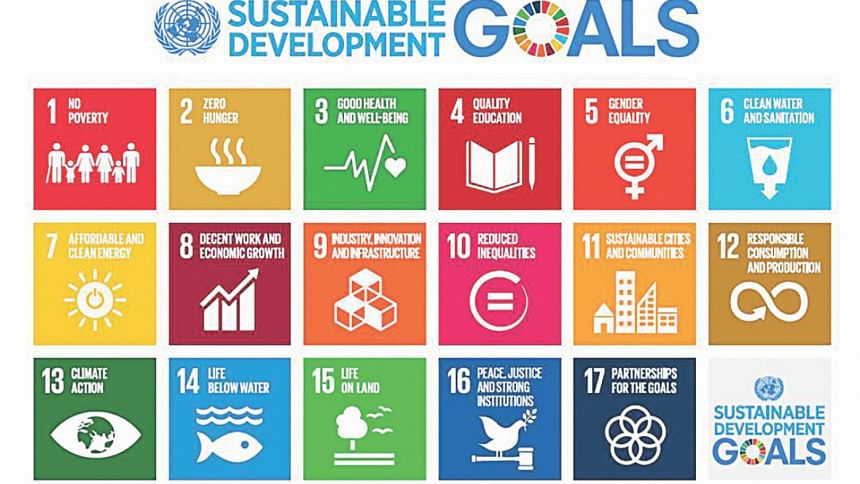The role of civil justice in achieving SDGs

Sustainable Development Goals (SDGs) came into force by a historic UN Summit with a view to mobilising efforts to end all forms of poverty, inequalities and tackle climate change, while ensuring that no one is left behind. The goals are interconnected and often the key to success on one will involve tackling issues more commonly associated with another. Issues related with civil justice like equal rights to economic resources, ownership and control over land and other forms of property, inheritance etc. (goals 1, 5), equal access to land, other productive resources and inputs for agro-based and small-scale business (goal 2), protection for labour rights, provision for foreign direct investment (goals 10 and 17) got some attention as targets to be achieved. In short, SDGs are a compilation of targets for economic solvency, social stability and environmental sustainability of the globe. This article focuses on the economic aspects of SDGs while discussing the importance of civil justice in its achievement.
Civil justice has a catalytic role in economic growth. An effective civil justice sustains social stability and economic growth which are necessary elements to achieve the SDGs. In Bangladesh, civil cases involve disputes relating to land ownership, land use, inheritance, performance of contracts and business transactions. In an empirical research, Professor Abul Barkat and Proshanto K Roy discovered that 76.58% of civil cases are land litigations. They found that the annual total amount of land affected by litigation was 2.35 million acres or 25% of the total arable land. They further discovered that lawsuits run for years together even as long as 50 years and each lawsuit, on an average, runs for 9.5 years. The economic consequences of such lengthy litigation are very severe. It is a key factor for downward mobility and vulnerability and it creates an environment for exploitation and pauperisation of the parties. Lengthy litigation accentuates distress and destitution among the parties, acts as a powerful disincentive against human capital formation, and causes a colossal wastage for the whole national economy.
There are many options suggested to remove backlog of cases, such as - increasing the number of judges, removing procedural complexities of civil cases, introducing digitisation, concentrating on ADR etc. Following a Working paper of OECD, I will use here the economics’ theory of supply and demand to discuss whether the present workforce in subordinate civil court is sufficient to reduce the case backlog. On the supply side, I will pose the number of resolved cases, on the demand side the number of incoming cases while the trial length will be considered as the price. As the price at which the demand and supply are the same is known as the equilibrium price, I will examine whether the number of filing and disposal are same at a given period to show whether there is an equilibrium trial length.
Case statistics of Bangladesh Supreme Court show that in the 2nd quarter of 2018, the number of case filing was 60,322 whereas the number of disposals was 55,911. So, there was a deficiency of 4,411. If the workforce could supply this deficient number within that quarter, it could be said that they were sufficient to establish an equilibrium price (trial length). However, if we consider this little supply deficiency lightly, we can say that the workforce was sufficient to satisfy the (demand) flow of case-filing. But the problem lies with the number of previously pending cases which ultimately constitute the total demand. In that quarter, the previously pending cases were 12,84,331 which made the actual demand (12,84,331+60,322) = 13,44,653 out of which the workforce disposed of 55,911 cases (only 4% of total demand). Since demand is far greater than the supply, the trial length (price) will definitely rise further and it will cross the above mentioned 9.5 years.
As most of the civil suits in Bangladesh are related with land disputes, the targets of SDGs mentioned in the first paragraph might not be implemented by 2030. In this backdrop, if the Judiciary of the country wants to establish an equilibrium trial length by only recruiting judges, it has to appoint 24 times more judges than the present number by 2030 - which is an unfeasible goal.
Therefore, apart from appointing judges on a regular basis, some innovative measures can be undertaken. For example, digitisation of the court system can be introduced. In a meeting with the honourable Justice Madan B. Lokur, head of e-committee of Indian Supreme Court, I learned that two-thirds of the trial length can be reduced by establishing e-court system. Furthermore, reducing high litigation rates through appropriate policies and effective ADR, reducing appeal rates, ensuring predictability of court decisions, introducing finality of judicial decisions etc. are essential for a significant reduction of trial length and thereby achieving the SDGs by 2030.
The writer is a Joint District Judge and Volunteer of SDG Lab.

 For all latest news, follow The Daily Star's Google News channel.
For all latest news, follow The Daily Star's Google News channel. 



Comments